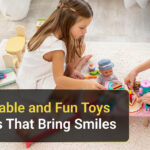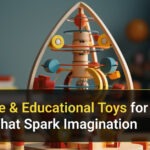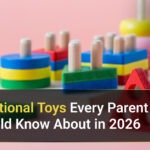Choosing the right playthings for your child is more than picking whatever catches the eye on the shelf. It’s about matching the child’s age, interests, and developmental needs with safe, fun, meaningful items. When selected thoughtfully, toys can support learning, creativity, physical development, and social skills. In this guide, you’ll learn what to look for, what to avoid, and how you can choose the best toys for kids in your care.
Why the right toy matters
Play is not just entertainment. For children, it is a key way they explore the world, process experiences, build skills, and express emotion. A toy that simply entertains may be fine in the short term, but a toy that challenges, engages, and is well-matched to the child’s age and interests will be far more beneficial. When you aim to buy the best toys for kids, you’re thinking beyond the novelty and into value: does this toy support growth? Does it wear well? Is it safe and ethically made?
It’s also worth remembering: what is best for a two-year-old differs from what is best for a seven-year-old. As children grow, their needs change, so your toy choices should evolve with them.
Key criteria for choosing toys
Here are some guiding criteria you should keep in mind when narrowing down options:
Age appropriateness & safety
Check the age range on the packaging carefully. Toys for toddlers should have larger pieces, no small detachable parts that can be choking hazards, non-toxic materials, and smooth edges. For example, the GRAFLO “60-Piece Magnetic Blocks – STEM Toy for Kids Ages 3+” is clearly marked for ages 3+ and listed under “Educational Toys.”
Safety also means durable construction and no easily broken parts. A cheaply made toy may pose sharp edges or loose parts after just a few uses.
Developmental match
Think about what your child is ready to explore next. A preschooler might love sensory toys, building blocks, or art kits. A school-age child might prefer STEM toys, craft kits, or ride-ons that challenge coordination and balance. For example, the GRAFLO “70-Piece Magnetic Tiles Set – STEM Building Toy for Kids 3+” is described as helping with spatial awareness, problem-solving, and open-ended creativity.
When you buy with development in mind, you are more likely to find the best toys for kids rather than simply fun ones.
Engagement & longevity
A great toy should offer more than a few minutes of play. It should allow the child to return to it and discover something new each time. Open-ended toys (those that have multiple ways to play) tend to have longevity. Avoid toys that do “one trick” only.
For example, a craft kit like the GRAFLO “Alphabet Bracelet Making Kit for Girls – 1100 Beads & Charms” accommodates many designs and many sessions and can grow with the child’s skill.
In that way, you’re more likely to buy among the best toys for kids rather than short-lived gimmicks.
Safety of materials & ethical factors
Check whether the materials are non-toxic and free of harmful chemicals (like BPA, phthalates) and that the toy meets safety certifications (UL, CE, ASTM as relevant). For building toys, strong magnets sealed inside are a plus. For example, the GRAFLO magnetic tiles set mentions BPA-free ABS plastic and sealed magnets.
Also consider whether the brand is transparent about manufacturing and packaging, and whether the toy encourages sustainable play. For instance, GRAFLO has an article on “Eco-Friendly Craft Kits for Kids” highlighting sustainability.
Variety & balance
When you’re building your child’s toy collection, consider including a variety of types: physical (ride-ons, scooters), creative (arts & crafts), building (blocks, STEM sets), social (board games, cooperative toys), and outdoor (equipment, nature-based). That way, your child gets balance.
When selecting for different categories, ask: is this one of the best toys for kids in its category (and age range)? If yes, include it; if no, skip it.
Using examples from GRAFLO
To make the guide concrete, here are some example products from GRAFLO that illustrate how to pick and what features to prioritize:
- GRAFLO 70-Piece Magnetic Tiles Set – STEM Building Toy for Kids 3+: This is a building toy with multiple pieces, strong magnets, and open-ended construction possibilities. A strong candidate for “best toys for kids” in the building/STEAM category.
- GRAFLO Alphabet Bracelet Making Kit for Girls – 1100 Beads & Charms: A craft kit encouraging fine motor skills, creativity, and personalization. Great for the creative category of “best toys for kids.”
- GRAFLO Kick Scooter for Kids – 2-Wheel Foldable Scooter with Adjustable Handlebar, PU Wheels: For physical play, movement, and coordination. A ride-on toy that gives activity and outdoor fun.
- GRAFLO Wooden Painting Kit for Kids – Glow in the Dark Arts & Crafts Set Ages 6–12: Combines creative art and novelty. Good example of choosing something that stimulates multiple senses and can be part of the “best toys for kids” in the art category.
When you plug in products like these while shopping (from GRAFLO’s shop), you anchor your choices in real, available items, making the process easier.
Age-based guidance
Here are suggestions by age group to keep in mind:
Ages 0-2 (Infants & toddlers)
- Focus on safety first: large parts, no choking hazards, durable materials, and minimal small moving parts.
- Toys that support sensory exploration: textured blocks, big soft balls, push/pull toys, and easy stacking cups.
- Limit screen-based distractions; favor hands-on play.
While the GRAFLO site focuses on a bit older, the same principles apply: look for simple construction sets, washable paints for toddlers, etc.
At this age, you’re choosing among the best toys when you prioritize safety and sensory over novelty.
Ages 3-5 (Preschool)
- Big leaps in language, motor skills, and social play. Toys that encourage imaginative play, building, role-play, and simple crafts are ideal.
- Open-ended building (blocks, magnetic tiles) is particularly useful. The GRAFLO magnetic tiles set works here (3+ years).
Art & craft kits can begin, especially with supervision. - Outdoor active play (riding, running, and throwing) becomes more important.
When you aim for the ideal toys in this age, ask: will this hold their interest, can they do it with minimal help, and does it support their growing skills?
Ages 6-8 (Early school age)
- Children are more curious about “how things work.” STEM toys become appropriate.
- Social play becomes richer: cooperative games, team building, and craft kits where they create, share, and gift.
- Active toys grow in complexity: scooters, bikes, and sports gear.
The GRAFLO site emphasizes this age group in its blog: “Best Toys for Early School Age (6-8 Years): Blending Fun with Learning.”
Ages 9-12 (Tweens)
- Children become more specialized in their interests: robotics, coding, serious craft, advanced building sets, and performance (music, sport).
- They also appreciate quality and durability over novelty.
- Social sharing and gifting become meaningful: they might craft for friends or build for family.
If you find a toy that can scale up or has levels of difficulty, you are closer to the best toys for kids in this age bracket.
Practical shopping checklist
Here’s a checklist you can use when you go to buy:
- Age-suitability clearly labelled.
- Safe materials, certified or at least described (BPA-free, strong magnets, smooth edges).
- Open-ended play potential (more than one fixed way to play).
- Balanced with the child’s interest (knowing what they like: art, building, outdoors, etc.).
- Durability and quality build (what’s the brand reputation? Are there reviews? For example, GRAFLO’s pages show reviews: “These magnetic blocks are absolutely amazing… my kids spend hours building…”
- Safe for your setting (if you have younger siblings, tiny parts may present a hazard).
- Room for growth: Will the child outgrow the toy quickly, or is there replay value?
- Balanced cost vs value: Sometimes more expensive toys last longer or offer richer features; sometimes simple, inexpensive ones are perfect for a short-term need (trip, playdate).
- If buying online (for example, from GRAFLO), check shipping, returns, and warranty. GRAFLO provides free delivery above AED 250.
- Avoid reliance on “screen-based” or “once-used gimmick” toys. Prioritize tactile, social, and active.
Mistakes to avoid
- Buying a toy just because it’s trendy or because the packaging is flashy. A toy that doesn’t match the child’s interest or age will sit unused.
- Ignoring safety or age warnings.
- Overlooking storage space: Some toys need lots of room or supervision.
- Buying too many similar toys (e.g., 5 building sets but zero outdoor or creative toys). Variety matters.
- Buying a toy to “keep them busy” rather than to engage them meaningfully. A passive toy may lead to boredom quickly.
- Underestimating the cost of extra required parts, batteries, or adult setup.
- Letting the gift-giver get carried away, sometimes the “biggest” gift isn’t the most meaningful.
When to choose a toy versus an experience
Sometimes the best investment isn’t a physical toy but an experience, an arts class, an outdoor adventure, building a fort, or gardening. However, combining the experience with a tangible item can be powerful. For example, after a nature walk, a craft kit from GRAFLO, like the Wooden Painting Kit for Kids, can bring nature into home play. GRAFLO+1
By doing this, you get an “experience plus object,” which can significantly enhance the value of your purchase and the time spent.
Recording “best toys for kids” as you go
Since we’re focusing on selecting the ideal toys, you may want to maintain a short list or spreadsheet of candidates. For each toy, write the age range, primary benefit (creativity, motor skills, STEM, outdoor), how many children share it (if siblings), storage/space needs, cost, and reviews.
As you review items (online, in-store), you can cross-check with the above criteria. Over time, you’ll build up a small set of trusted brands and product families. For example, GRAFLO’s categories (Educational Toys, Art & Crafts, Scooters) give you a useful structure to filter.
Family / Parenting tips when supervising toy use
- Set aside dedicated playtime, not just “whenever.” That helps the child value the toy and use it thoughtfully rather than passively.
- Participate sometimes. Even when the toy is “for the child,” you playing alongside them or asking open-ended questions (“What do you think will happen if you build it taller?”) increases learning.
- Rotate toys. Particularly for younger children, consider putting some toys “in storage” for a month and then re-introducing them; they will feel new again.
- Encourage “teach me” or “show me” sessions. When a child plays and then teaches you what they built, it strengthens their engagement.
- Use the toy for social play. Invite a friend over with the building set, craft kit, or scooter. Play is richer when it’s shared.
- Link the play with the story. For example, with a bracelet kit, ask, “What word will you spell with beads?”; with a building set, ask, “Can you build a spaceship or a castle?”
- Clean up after play. Teaching children to tidy their toys, sort pieces, and store them properly helps prolong their lifespan and gives them a sense of responsibility.
Summary and Conclusion
Choosing the right toy for your child isn’t about following trends; it’s about finding what truly supports their growth, creativity, and happiness. Focus on age-appropriateness, safety, and developmental value rather than flashy packaging or short-lived excitement.
When you buy thoughtfully, you’ll find the best toys for kids, those that engage, educate, and entertain. Brands like GRAFLO offer a wide variety of quality options, from STEM building sets to craft kits and scooters, helping you choose toys that last and inspire real play.
In the end, the best toy is one that sparks joy, fuels imagination, and keeps your child coming back for more.






